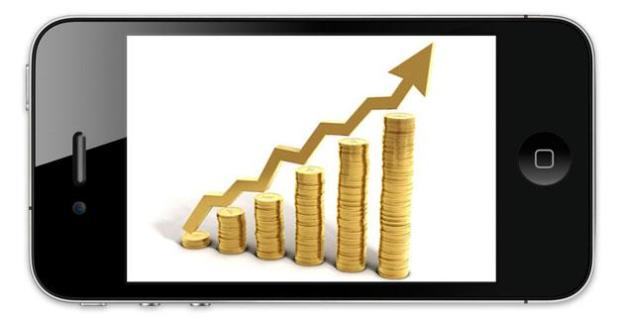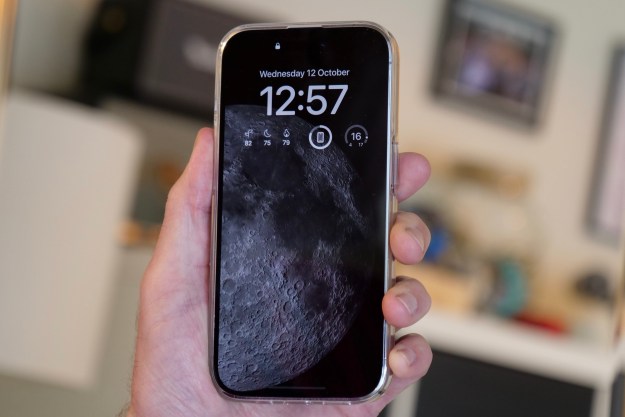
All four major U.S. cell phone carriers have now released their financial results for the fourth quarter of 2011, and all three of iPhone carriers tout their success during the quarter, bolstered by new subscribers to their wireless voice and data services. No surprise for a phone more popular than all Android smartphones combined, right?
But with it comes a heavy toll. The Apple iPhone carries a higher subsidy than any other phone the carriers offer, which means it takes longer for the carriers to make a profit from iPhone users compared to Android users or those preferring BlackBerry, Windows Phone, or other platforms. In the meantime, innovations like Apple’s Siri voice-based search capability (as well as the ubiquity of streaming music, video, games, and other interactive content) mean providers’ networks are struggling harder than ever to keep up with data demands.
The result? Mobile operators are seeing their profits shrinking at the same time they’re sending trucks full of money to Cupertino. How are carriers likely to respond? That’s right: by raising your rates.
We opened the ledgers to see why how the heavy cost of the iPhone makes its way to your wallet.
 Verizon
Verizon
Verizon Wireless was the first out the door with its quarterly results, touting a 7.7 percent increase in revenue during the fourth quarter of 2011 compared to 2010. Sounds good, right? It gets better: Verizon Wireless revenues grew by 13 percent during the quarter to $18.3 billion — that’s a record. Part of that success came from the sale of some 2.3 million 4G LTE devices to customers who just have to be on the leading edge of mobile broadband. Overall, the company sold 7.7 million smartphones during the quarter: A whopping 4.2 million of them were Apple iPhones.
And therein lies the rub: Thanks in part to the subsidies associated with those iPhone sales, Verizon Wireless actually saw its earnings drop five percent during the quarter, and the company’s profit margin on wireless dipped from 48 percent in the third quarter of 2011 to 42 percent during he holiday-blessed fourth quarter — declining profit margins during the year’s biggest retail quarter is not something investors want to hear.
And the iPhone’s effects at Verizon are not new to the iPhone 4S. With the exception of the third quarter of 2011 (when iPhone sales slacked a bit as potential customers waited for the “next” iPhone) Verizon has seen its profit margin on wireless drop by as much as 10 percent.
Verizon’s chief financial officer Fran Shrammo largely sidestepped the issue of how the iPhone was impacting Verizon Wireless’s finances, saying that the company had its costs under control and that profit margins in other segments of its business were growing. Furthermore, Verizon expected its cost-to-earnings ratio to improve considerably as it expanded its LTE network and migrated customers to 4G services. Right now, Verizon’s 4G LTE offerings are a successful high-priced niche product.
But Shrammo admitted Verizon Wireless was considering price increases — this from a company whose rates are already at the high end of the industry.
 AT&T
AT&T
AT&T was in the cat-bird seat for the iPhone in the U.S. market, having an exclusive lock on the device until Verizon started offering the iPhone 4 about a year ago. However, that doesn’t mean AT&T is doing any better at managing the iPhone’s effect on its profit margins. During the fourth quarter of 2011 AT&T sold some 7.6 million iPhones — that’s almost twice as many as Verizon — and pulled in some $16.7 billion in total wireless revenues for the quarter, a 10 percent increase from the fourth quarter of 2010.
Nonetheless, the iPhone effect is front and center in AT&T’s financial results. The company sold 9.4 million smartphones during the quarter, and over 80 percent of those were Apple iPhones. At the same time, the company saw its service margin for wireless customers shrink to 28.7 percent — back in the fourth quarter of 2010, that was 37.6 percent. In other words, AT&T is selling more iPhones than ever, and in the last year it has seen its profit margin for wireless operations shrink by almost a quarter. Again, shrinking profit margins are not the sort of things that make investors happy, particularly in the costly wake of AT&T’s abortive attempt to take over number-four U.S. mobile operator T-Mobile.
As the longest-standing carrier with the iPhone, AT&T’s situation with the device is more diverse than Verizon or Sprint. For instance, AT&T is the only carrier able to offer the two-generations-old iPhone 3GS—which it offers to customers for free with a qualifying contract, but presumably pays a far lower subsidy to Apple than it does for a brand-new iPhone 4S.
Sprint
Sprint just released its results for the fourth quarter of 2011, and like AT&T and Verizon it’s having solid success selling the iPhone, moving 1.8 million of the devices during the fourth quarter alone. Sprint seems particularly chuffed about having the iPhone in its arsenal, saying that 40 percent of new Sprint mobile customers are buying iPhones. That has to be good news for Sprint: Last autumn, Sprint CEO Dan Hesse said that the top reason customers were leaving Sprint was because they wanted an iPhone — and Sprint didn’t have one.
However, the iPhone hasn’t been all roses for Sprint’s financials. In the fourth quarter of 2010, the iPhone-less Sprint was earning a 16 percent profit on its wireless operations. At the end of 2011, launching the iPhone, Sprint’s wireless profit margin dropped to just 9.5 percent. And being the third player at the iPhone table, Sprint had to pay dearly for the privilege: it has promised to pay Apple in the neighborhood of $15.5 billion over the next four years even if it doesn’t sell a single additional iPhone, and in a call with analysts CEO Dan Hesse outright admitted the company does not expect to make any money on iPhone sales until 2015.
 The carriers’ dilemma
The carriers’ dilemma
Mobile carriers are between a rock and a hard place when it comes to the iPhone: On the one hand, doing business with Apple is very expensive, thanks to substantial handset subsidies. Although exact figures haven’t been disclosed, industry consensus is that Apple extracts anywhere from $425 to $500 from carriers up front for every current iPhone they sell, with lower numbers associated with the iPhone 4 and the still-older iPhone 3GS. That’s roughly double the subsidies carriers pay for smartphones from other manufacturers, including devices from the likes of Samsung, Motorola, and HTC that are arguably more advanced than the iPhone (whether that be through larger screens, faster processors, better graphics, more advanced cameras, or 4G LTE capabilities).
However, the cost to carriers of not having the iPhone are enormous: Just ask T-Mobile. T-Mobile’s financial results for the 2011 holiday quarter aren’t due for a few more days, but the industry consensus is that while T-Mobile will likely continue to have some short- and medium-term success, particularly in the pre-paid market, the carrier’s lack of any path to 4G LTE services and inability to sell the iPhone to its customers are major hurdles. During its third quarter of 2011 (which ended in October 2011), T-Mobile lost 186,000 contract subscribers, even as the number of customers using smartphones on its network increased by 40 percent. Although T-Mobile is going to pick up a chunk of cash and some spectrum licenses from AT&T as a result of the cancelled merger, most industry watchers expect the carrier’s overall churn to increase as customers continue to look for other carriers that either offer LTE or the iPhone — or perhaps both with a future iPhone. And T-Mobile would love to offer the iPhone; Apple just isn’t making one that works with its unique “4G” HSPA+ network.
So being able to offer the iPhone is currently crucial to a U.S. carriers’s ability to maintain or gain share in the smartphone market. Some 80 percent of the smartphones sold by AT&T are iPhones. Although the proportions are lower for Verizon and Sprint, the iPhone accounts for a substantial proportion of both carriers’ smartphone sales. Without the iPhone, their smartphone stories would be very thin.

Higher prices
The combination of having profit margins eaten away by the most popular smartphone on the market coupled with the up-front capital expenditures of building out LTE services leaves carriers in a lurch: They need to earn money to keep their stock prices up and their investors happy, but they also need to invest in next-generation services so they aren’t out-maneuvered by competitors.
The only way for carriers to balance that equation is to generate more income — and, for smartphone users, that’s most likely to come in the form of increased costs for wireless service. It’s already starting to happen: A year ago Sprint jacked its service prices by $10 a month, and last month AT&T added $5 a month to the cost of its mobile plans (along with massively increased fees for overages). Verizon hasn’t followed suit yet, but Verizon also has the healthiest margins of the four major U.S. mobile carriers. These price increases don’t just apply to iPhone users: They cut across the company’s entire mobile customer base.
The upshot here is that the high up-front costs of the Apple iPhone (and Apple’s record-setting financial results) are indirectly driving up smartphone costs for U.S. mobile users, whether it be someone buying an inexpensive Android device as a starter smartphone or someone going full-bore with one of the first LTE devices.
In an ironic twist, the revenue pressure on AT&T, Verizon, and Sprint could create a unique market opportunity for T-Mobile. As rate increases make smartphone costs on the three biggest carriers too painful for some consumers, T-Mobile might be able to swoop in by offering lower-cost data subscription and pre-paid plans. The problem, of course, is that a huge proportion of the three largest carriers’ user bases who might be alienated by rate increases are on iPhones. So far, there don’t seem to be many iPhone users who abandon the platform in favor of Android, Windows Phone, or other platforms. That means, like it or not, many smartphone users are just going to grin and bear it when their carriers raise their rates.
Editors' Recommendations
- Why you should buy the iPhone 15 Pro instead of the iPhone 15 Pro Max
- 3 reasons why I’ll actually use Anker’s new iPhone power bank
- This iPad just got a rare discount — save $100 at Best Buy
- How to connect an iPhone to a Mac with or without a cable
- What is NFC? How it works and what you can do with it





